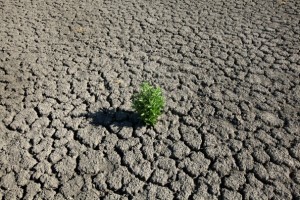Ten Things You Should Know About the Texas Drought

Scott Olson/Getty Images
A weed grows out of the dry cracked bed of O.C. Fisher Lake on July 25, 2011 in San Angelo, Texas.
It’s a question on everyone’s mind, one with an elusive answer – when will the drought end? John Nielsen-Gammon, the state’s climatologist, has been busy briefing lawmakers on how we got here, if there’s an end in sight, and whether or not this may be the new normal. Using his report that he presented last week to the Texas State Legislature, The 2011 Drought, below, here are ten things you should know about the Texas drought:
- How bad is it? The current drought “has been the most intense one-year drought in Texas since at least 1895 when statewide weather records begin, and… it probably already ranks among the five worst droughts overall.”
- When did it start? The 2011 drought began in October of last year, but quietly. While the fall and winter were relatively dry, by the spring it had truly arrived, with a record dry March through May, and then a record dry June through August.
- What about the extreme heat? This summer’s average temperatures were “2 °F above the previous Texas record and were close to the warmest statewide summer temperatures ever recorded in the United States.”
- Was the heat directly related to the drought? According to the report, they both fed off each other: “the record warm weather during the summer in Texas was primarily a consequence of the lack of rainfall, but the heat and resulting evaporation further depleted streamflow and reservoir levels.”
- Did anyone get any rain? Not really. Many weather stations in the state recorded less than 25% of their normal rainfall. The one part of the state that had some relief was “the area near, north, and east of Dallas.” which Nielsen-Gammon says was “comparatively well off” versus the rest of the state, but still had “serious drought conditions and record heat.”
- How does this drought compare to previous ones? “The statewide drought index value has surpassed all previous values, and it has been at least forty years since anything close to the severity of the present drought has been experienced across Texas.”
- Is it possible this drought could end up being even worse? Yes. The 12-month rainfall total for the last year was “far below the previous record set in 1956.”
- When will it end? “Because of the return of La Niña conditions in the tropical Pacific, a second year of drought in Texas is likely, which will result in continued drawdown of water supplies.”
- And what about after that? “Whether the drought will end after two years or last three years or beyond is impossible to predict with any certainty, but what is known is that Texas is in a period of enhanced drought susceptibility due to global ocean temperature patterns and has been since at least the year 2000.“
- So is there any good news here? Yes. Nielsen-Gammon says in his report that “the good news is that these global patterns tend to reverse themselves over time, probably leading to an extended period of wetter weather for Texas, though this may not happen for another three to fifteen years. Looking into the distant future, the safest bet is that global temperatures will continue to increase, causing Texas droughts to be warmer and more strongly affected by evaporation.”
Source: The 2011 Drought, by Texas State Climatologist John Nielsen-Gammon
Read more at the state climatologists’s blog, Climate Abyss.



